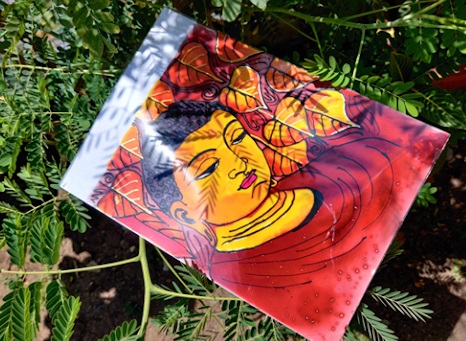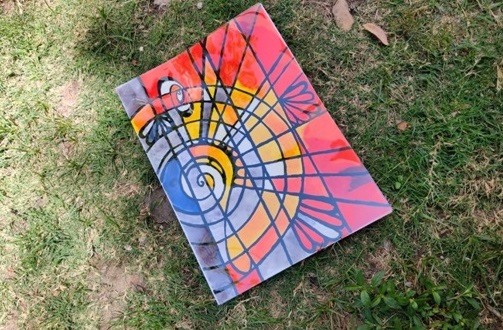Glass Painting, An Art Beyond Skills. In this article you will get all the information about what is Glass Painting, What are the types of Glass Painting Art Work, How you can start Glass Painting Artwork at Minimal Cost right away.
Contents
- 1 Glass Painting: An Art Beyond Skill
- 2 Evolution of Glass Painting
- 3 Faith of Glass Painting Art in India
- 4 FAQs Related to Glass Painting.
- 4.1 What are the ideal colours used? Where can we buy Glass painting colours?
- 4.2 Where We can Get Glass from?
- 4.3 Is it necessary for glass painting to have plain glass can’t glass painting be done on a wine glass bottle or any other?
- 4.4 What all stationary and tools are needed for a beginner glass painter?
Glass Painting: An Art Beyond Skill
It is rightly said by Edward Hopper “If you could say it in words, there would be no reason to paint”. Painting is such an art, where words can’t express art does that in the most beautiful way. Even the early men started conversing through drawings, cause the expression of art is beyond words and Glass painting is such an art.
Glass paintings are very much popular artefacts that art lovers and many others like to collect. It makes use of vibrant synthetic colours on the glass as a base. The overall appearance of glass and semi-transparent paints together provide a very ethnic look.
Evolution of Glass Painting
Glass painting has been a folk art tradition in the countries of Europe and North America from the 15th to the 18th century and was regarded as fine art in northern Europe, where they have been more recently revived. Glass painting is a special kind of drawing painted on the inside surface of the transparent glass and is being executed with oil and hard resin or with watercolour and gum on glass sheets. A very different form of glass painting is the reverse glass painting wherein, engravings are laid down on the back of the glass, and painted from the reverse.
Glass paintings today have gone beyond just window decorations. From cutlery and wall hangings to clocks and table tops, glass wares are being given a coat of color to embellish them and define the personality of the painter and subsequently the collector or owner.
Indian glass paintings have come a long way from the 18th century beginning in Gujarat to helping homemakers all around the country fill their pastimes.
The effect is one of stunning clarity and rich colour which usually ideally serves as a connoisseur’s delight. Glass painting usually allows an expressive mix of form and dimension to be added to the glass. Here I’m sharing some of my artwork where I tried different forms of Glass Painting. I used Fevicryl Glass colours which are water-based to paint these.
Distinctive Glass Painting you Would Come Across the Globe
1. General Glass Painting

In this, I painted a woman who hides a storm in her face with that alluring eye. She depicts divine beauty with simplicity. This is a general Glass Painting for which I drew the sketch on a sheet first then traced it on the glass.
2. Reverse Glass Painting

Buddha, the epitome of “Peace” and “a sea of serenity” is portrayed here. He is the embodiment of enlightenment which we can clearly see in all of his sculptures and portrays. To paint it I used several shades of different colours and blended it well to make the look of a divine.
This is a Reverse Glass Painting which is a form of Glass Painting, this type features painting the glass on the back side i.e back glass painting. This technique is a comparatively newer form of glass painting and a rather economical and weather proof one. This technique is usually used for making glass wall hangings and clocks. The world famous Tanjore Glass Paintings are usually done in the reverse form.
3. Abstract Glass Painting

This one is an example of Abstract Glass Painting, Abstract art uses the visual language of shape, form, colour and line to create a composition which may exist with a degree of independence from visual references in the world. Abstraction indicates a departure from reality in depiction of imagery in art. This piece of work can be depicted as Musical Abstract Glass Painting.
4. Stained Glass Painting

This can be an example of what is called Stained Glass Painting, this is an older form of glass painting. Europeans used to literally stain glass in metallic salts and then bring them together to form a picture and stick each glass piece with lead strips on another glass support.
Stained glass paintings are usually seen on window panes and table tops, Churches and Mosques. With Modern Times the process is changed. There is a particular pattern and shapes which are followed in making of it which can be identified.
Faith of Glass Painting Art in India
Glass painting was brought by the Chinese to the Gujarat artisans in India, in the 18th century. Gujarat became a hub for glass painters and patrons. Tanjore glass paintings are famous all around India and the world for its vibrant colors and use of precious and semi precious stones, gold foil and other jewels to decorate the paintings, making it valuable and a sought after collector’s item.
The themes of Indian Glass Painting, earlier, included Hindu gods and goddesses and scenes out of epics like Ramayana and Mahabharata. Gradually the variety of themes expanded to portraits of famous personalities, geometrical designs and nature. So, Glass Painting has come a long way.
Stationary Tools you may need for Glass Paintings
- Permanent Marker- to Trace/make the Drawing/Sketch
- Glass Colours- Fevicryl Water Based Glass Colours or Camlin Glass Colours
- OHP Sheet/ Glass
- Safety Pin ( To Pinch bubbles)
Handpicked Glass Painting of Gautama Buddha
FAQs Related to Glass Painting.
What are the ideal colours used? Where can we buy Glass painting colours?
Primary colours can be used as ideal colours and by blending them well, we can create secondary colours too.
Where We can Get Glass from?
Glass Shops and Photo Frame Shops. Choose the glass size according to the size of the painting. You can get OHP Sheets instead.
Is it necessary for glass painting to have plain glass can’t glass painting be done on a wine glass bottle or any other?
No, it’s not necessary. Glass Painting can be done on any surface including wine glass, bottle, Glass plates, bowl etc.
What all stationary and tools are needed for a beginner glass painter?
For beginners, it’ll be good to start with Fevicryl Water Based Glass Colours and for initial paintings, one can use OHP Sheets rather than Glass for practice and than can switch to Glass.

